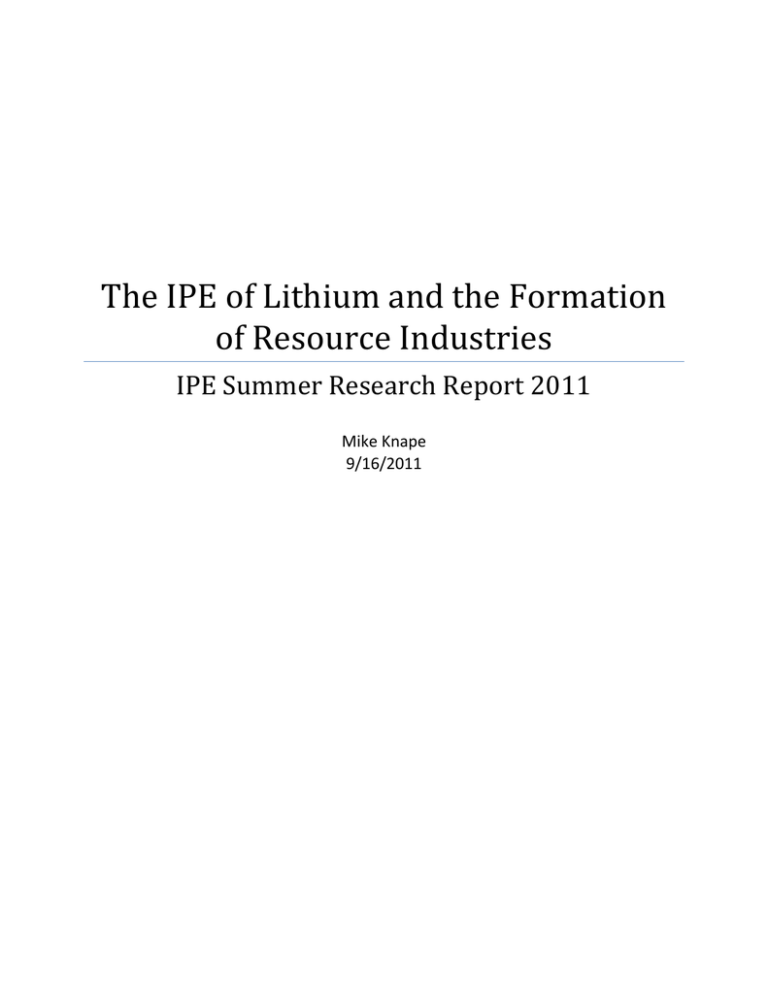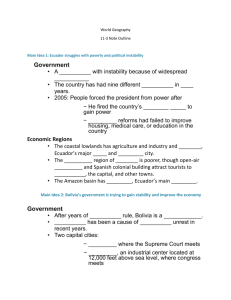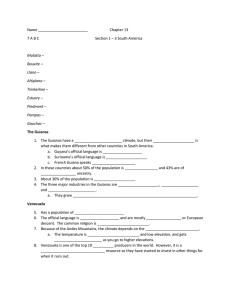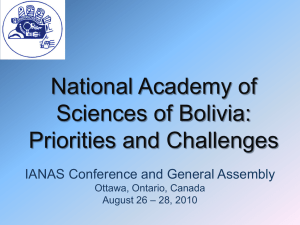The IPE of Lithium and the Formation of Resource Industries
advertisement

The IPE of Lithium and the Formation of Resource Industries IPE Summer Research Report 2011 Mike Knape 9/16/2011 Knape 1 Description of Research At the outset of my project, my research centered on explaining how the current lithium industries in Chile and Bolivia were formed. Essentially, my central question was how are the current resource models created out of the historical context and how NGOs, MNCs and other non-state actors influence lithium production. This focus stemmed from a particular interest in the drastically different political histories of both nations. Tracing the roots of ingrained economic policy back to previous political regimes seemed a new and dynamic way of approaching the issue. How did Chile’s gradual democratization in the late 1980’s lead to the unique mix of strategic government intervention and unregulated free-market situation that characterizes the world’s biggest lithium producer, for example. Or how did the Bolivian water riots of the early 2000’s help shape the economic populism that brought current president Evo Morales to power? The historical context cannot be separated from the cultural context however, as the two forces have developed hand in hand. Luckily, fieldwork provides the perfect setting to examine both concurrently. Another main focus of my research was focused on how different societal actors influence the political economy of Lithium. Like anywhere in today’s global economy, the role of NGO’s and MNC’s are impossible to ignore. These international actors, especially environmental groups and multinational mining or tech conglomerates, wield enough power in other arenas to warrant further study in this specific case study. Multinationals and international organizations are polarizing issues throughout Latin America due to popular perceptions of northern imperialism. Chile, and especially Bolivia, are no exceptions. Perhaps the most important sub-question on this subject however, is with regard to indigenous communities. I sought to understand how indigenous organizations and identities affect the political economy of Knape 2 lithium in Bolivia and Chile. Do the empowered indigenous communities of Bolivia have stronger qualms about extractive mining processes like those necessary for the production of lithium? Does a strong communal indigenous identity contribute to the unity of populist movements that can lobby for government assistance, whether in the form of welfare programs or job-creation projects? This category of secondary questions was supposed to bring a human, social quality to the research. Technical questions regarding the two countries’ political economies and lithium production as a scientific and economic process made up the rest of my original research goals. As a foreign observer, I felt that it was of vital importance to learn as much as I possibly could regarding country-specific information like political institutions and economic makeup. I already possessed much of this background for Chile due to my prior experiences there, but I knew almost nothing of Bolivia. To responsibly examine this country as an IPE case study, especially with perspective-laden evidence like domestic political history, I wanted to know as much as possible given my time constraints. I set out to learn the basic technological and scientific ideas inherent in the lithium industry for similar reasons. Understanding what makes lithium unique as a substance and also as an industry is necessary in order to apply my case study findings to other resource industries. Likewise, understanding these details allows you to make statements regarding the significance of lithium industry on a community, national, and international level. Environmental degradation, employment opportunities, and rentability/profit margins are prime examples of useful details. On a more basic level, understanding the technical issues facing the industry helps when evaluating corporate actions or government policy decisions. My research methodology focused on interviews with important analysts and actors in the industry, supplemented by academic research. Focusing on interviews allowed me get in-depth Knape 3 perspectives from a diverse array of subjects. Although they ranged from a mere 30 minutes to over three hours, each interview exposed me to a new way of thinking about my project. Interviews were conducted in Bolivia and Chile over a 10-week period from June until August of 2011. I conducted ten formal, at-length interviews, plus a number of shorter spontaneous conversations. Among my interview subjects were university professors, chemical engineers, career bureaucrats, economists, and elected politicians. In the political arena, my most important interviews were with Reinaldo Cuadros, the former Bolivian ambassador to the Organization of American States, and the director of foreign relations and communications for the Bolivian State Mining Corporation (COMIBOL), Evert Villena. I also had the opportunity to interview Juan Carlos Zuleta, who is one of the foremost economists studying lithium. For technical information I spoke with materials engineers working for COMIBOL’s division of evaporative resources, which focuses on lithium, as well as chemical engineers at the SQM, the world’s largest lithium producer. I also interviewed Jaime Claros, a professor of chemical engineering at the Bolivian Autonomous University of Tomás Friás who is spearheading an international effort to develop a new method of lithium extraction that maximizes yields while minimizing environmental impacts. Finding research subjects to interview was one of the main difficult parts of this process. The couple of connections I had before arriving in Latin America ending up being vastly more important as networking resources than interviewees, as networking would become my most valuable asset. Internet access is especially limited in Bolivia and northern Chile, which made finding and contacting new sources more difficult. Few Bolivian newspapers are published online, for example, and rare is the businessman or academic that uses email more than once a week. Consequently, probing my connections and subsequent interview subjects for colleagues’ Knape 4 contact information was essential. I was lucky to have well-connected acquaintances that could get me started. These connections also served as resources for me when trying to navigate the intricacies of bureaucracy and business structure. They informed me of what paperwork I needed, who to contact originally, and even walked me to where I needed to go. Without these resources, I would have never have gained access to the sources I found. I traveled almost constantly during my research in the pursuit of interviews, starting in La Paz, Bolivia and ending in Santiago, Chile. After close to two weeks in La Paz, I spent time in Cochabamba, Potosí, and Uyuni before crossing the border to Chile. I visited the Chilean cities of Calama and Antofagasta before heading south to Santiago. Overnight bus was my usual mode of transport, although I took a train once when winter weather closed roads. Travel was a necessary part of my research primarily because lithium production takes place in geographically remote regions far from political and economic centers. Likewise, both nations exhibit incredible regional diversity that warrants exploration. The distribution of indigenous communities in Bolivia, for example, actually follows topographical boundaries rather than any political or latitudinal indicators. The large Aymara population resides in high elevations like La Paz (situated at a lofty 12,000ft), whereas the lowland valley areas like Cochabamba are predominantly Quechua. It was important to pursue interviews in different locations because Bolivian politics closely follow these ethnic lines. Chile is similarly regional thanks to its almost unparalleled longitudinal span that encompasses vast geographic differences. Aside from interviews, my research afforded me the opportunity to tour an actual production facility. I toured COMIBOL’s pilot plant while visiting the Bolivian town of Uyuni, which is located right at the edge of the Salar de Uyuni. The Salar de Uyuni is a salt flat that covers over 4,000 square miles and contains the largest reserves of lithium in the world. While Knape 5 the plant was designed for an experimental level of production and some sections were still under construction, it was an incredible chance to see the preliminary results of state-led industrialization. I was allowed into the facility’s labs and rode a tractor out onto the flooded salt flats to visit the evaporation pools that produce lithium-rich brines. Although I had been told that I would not be able to talk to employees by the COMIBOL official that gave me permission to visit, most everyone was more than happy to answer my questions and show me around. The day I spent at the Salar helped me understand how the social, economic, and political elements of my research all fit together. Seeing the effects of the government project on the local economy and community put all of the information I had gained from economists and politicians in a different light. Sitting in on a Bolivian political forum regarding a controversial new agriculture law was similarly eye-opening. Thanks to a friend-of-a-friend who is a prominent member in La Paz’s civil society, I was treated to four chaotic hours in the crucible of populist policy-making. The event featured presentations from the Minister of Agriculture, two Senators, and an array of indigenous community leaders known as allyu. The strike-paralyzed street outside the bourgeoisie hotel that hosted the seminar was filled with picketing protestors. In the penthouse suite where the event took place, rarely would a speaker make it through more than half of their presentation before being interrupted by shouts from the audience. The entire atmosphere buzzed with nervous energy and nothing could have struck me as farther from the American political system. While some cultural differences struck me as unfathomably rude, (interruptions, loudly making phone calls from the front row of the audience, etc) it was a crucial experience in understanding the Bolivian political system. For the most part, the audience expressed a fear bordering on paranoia towards commercially-farmed genetically-modified produce and Knape 6 demanded government handouts and subsidies. Despite my own feelings on the subject, the most striking aspect of the entire situation was the stark absence of any large commercial cooperatives. Here was an important opportunity to discuss a pivotal issue for Bolivian agriculture, and no one invited the faction that accounts for over three-quarters of domestic production. While lithium-related industries never came up, this experience proved a telling look at the state of the Bolivian political economy. Public libraries and local academics were other useful resources I took advantage of during my research. The National Library of Chile is located near where I was living in Santiago and is required by law to carry at least one copy of everything published domestically. I spent three different afternoons poring through catalogs in search of documentation that I knew would be hard to find in the US. I spent some time in the library of the state press agency in La Paz, but that was less useful and it ended in me almost being deported for not carrying the right visa information. During my time in northern Chile I met with two university professors that helped me find research on my topic. Since they were both focused on the copper industry they had no specific knowledge of lithium, unfortunately, but they knew where to find reports and statistics from the government and industry publications. Making use of whatever resources I could find, even if they were not perfect, was necessary throughout my research. Budget The allotted budget was absolutely sufficient to carry out my research, thanks to a couple of unique circumstances. First of all, living and traveling in Latin America is generally much less expensive than the US. Chile’s overvalued currency makes it more on par with the US, but Bolivia is vastly cheaper. A typical night at a hostel or cheap hotel in Bolivia comes out to around US$6; practically gourmet meals are around US$4. Chile runs more in the US$15-30 Knape 7 range for a hotel and US$9-12 for a nice meal. So although I think I ended up spending more time in Bolivia, the overall cost was pretty even. Other than my plane flight to and from South America, transportation costs were cheap. Discomfort certainly came with the lower costs in Bolivia, but an eight-hour bus ride for ten dollars is hard to beat. In a more expensive part of the world like North America or Europe, my daily costs would have been significantly higher. Likewise, if I had only focused on Bolivia I could have saved probably $1000, but the opportunity to compare two almost diametrically opposite political economies justified the elevated cost. Secondly, being able to stay with friends helped alleviate some of my costs. The cousin of my original connection in La Paz owned a hotel in downtown where I was able to stay for half price for ten days. In Cochabamba, I spent three weeks sleeping on a futon in my friend’s storage room free of charge. I ate three meals a day there and even walked his kids to school in the mornings. I saved money and had an amazing cultural experience at the same time. Because of the connections I had made in and around Santiago during my study abroad term there, I had no problem finding free lodging during my weeks there. Despite these advantages that helped allay some costs, airfare proved to be by far my biggest single expense. I spent $1,400 on my plane ticket to South America. Lodging accounted for around $1000 and food slightly less. Entry visas were close to $300 and ground transport was around $500-600 more. I had to rent a private driver for my trip to the Salar de Uyuni, which accounts for $150 of that transport cost. Obviously there were some personal costs as well, like a ski trip in the Andes, but I am not including them in the budget. My accounting for research expenses was made more difficult by an unfortunate turn of events in Cochabamba, Bolivia. I had a backpack with all of my valuables stolen in the bus Knape 8 terminal while waiting to leave for a weekend trip to the jungle. Digital camera, laptop computer, passport, visas, credit cards, gone. Although my parents’ insurance ended up covering almost all of my losses, I had to replace some things like my voice recorder. Preliminary Findings While I am continuing this project as my senior IPE thesis, a number of preliminary conclusions have become clear. My original central question shifted somewhat over the course of my fieldwork as well, more towards an evaluation of public vs. private firms in the lithium industry than an examination of how the two resource industries formed. Historical political trends remain important as factors that determine the optimal mix of public and private firms, as well as the influence of non-state actors. At its core, my fieldwork exposed how differences in Chile and Bolivia’s historical economic stability, geology, and political movements explain why Chile remains the worlds’ most important lithium producer and why Bolivia has still not sold a gram twenty-five years after it labeled lithium a national priority. The lack of consistent juridical stability in Bolivia was a recurring theme that I encountered in my research. Due to years of military coups and popular uprisings, Bolivia has not really maintained a stable economic system in the modern era. Leftist movements of the 50’s and 60’s gave way to decades of corruption under military rule, followed by a general liberalization of the economy in the mid-90’s under democratically-elected former dictator Hugo Banzer. The neoliberal approach lasted less than a decade and current president Evo Morales “Movement Towards Socialism” (MAS) government took power in 2005 under a banner of indigenous rights and nationalization of the natural gas industry. By comparison, in Chile the staunchly neoliberal political economy established under military dictator Pinochet in the late 1970’s remains essentially unchanged today. This stark contrast in juridical stability helps Knape 9 explain the vast differences in foreign investment and trade. Now consider lithium industry, a highly capital-intensive investment with slow returns given the nature of production. Similarly, Chilean political stability led to extensive infrastructure projects throughout the lithiumproducing region in order to foment the booming copper industry. Public works in Bolivia suffered from a lack of a financing copper industry, but also from corruption. Both nations suffered from authoritarian regimes in the 70’s and 80’s, but only Chile presented a favorable opportunity to foreign firms looking into evaporative mining. A second key distinction between the Chilean and Bolivian industries is geologic in nature. Simply put, extracting lithium is significantly easier in Chile’s Salar de Atacama than in Bolivia’s Salar de Uyuni, despite the size of overall reserves. This is due to a couple of factors, namely evaporation rates, relative concentrations of lithium to other minerals in the brines, and seasonal precipitation levels. The standard production process for lithium carbonate, which is the most common commercial form, requires months of evaporation to reach acceptable concentrations. Lower evaporation rates in Bolivia lengthen this phase of the project by two or three months compared with Chile. Similarly, southern Bolivia suffers from a nearly five month rainy season, which can flood the evaporation pools and dilute the chemical solution. When I was in Uyuni, the entire Salar was flooded under 50 cm of rainwater. This complicated transportation around the facility and ongoing construction efforts. To contrast, Chile’s Salar de Atacama is one of the driest places on earth. The ratio of lithium to magnesium and other minerals is measurably different between the two sites as well. In Chile the ratio of lithium to magnesium is between 1:6 and 1:8, in Bolivia it is between 1:18 and 1:24. This makes the chemical extraction process less efficient and drives costs up. All of these factors help make the Chilean industry more efficient and competitive. Knape 10 Reflections Aside from what I learned about my research topic, I gained a number of insights from the research process itself. First, doing field research is all about rolling with the punches and being flexible. As I learned through my experience with theft, there are some things you simply cannot plan for. What’s more, half the appointments and plans you do make will be changed. For example, the Bolivian public transportation unions were organizing almost weekly nationwide strikes during my time in the country. Not only could I not travel on those days, but interviews had to be postponed because interviewees did not have cars and could not travel into town to meet. Chile is in the midst of one of the largest student protests in its history, prompting general nationwide strikes in support of the students’ demands. I was obviously powerless to change anything, so days of strike turned into opportunities to walk around town exploring or transcribing interviews. Because strikes often would be scheduled to border weekends or national holidays, some weekends stretched for four or five days. In these situations I found that the best thing to do was to shrug off the delay and try to really take advantage of the business days that I had. As such, I pretty much exclusively traveled on weekends so as not to lose more time. Fieldwork, especially in developing countries, is not an exact science and I needed to remember that in order to stay positive and productive. Another lesson I learned from doing fieldwork is the importance of introductions and quick explanations. When conducting or requesting interviews, I felt like I had maybe 30 seconds at most to explain exactly who I was, what I was doing there, and what I needed. If I was vague on what I was doing or the subject could not figure out how they fit into my project, I lost credibility and respect before the interview even began. Given the language barrier, this was definitely the most stressful part. Unfortunately, time is a precious commodity for anyone worth Knape 11 talking to and first impressions are crucial. My solution to this issue was background research and individual preparation for each interview. I used whatever biographical information I had or could find on the internet and tried to piece together the direction of the interview. Having a personal connection to the subject, being able to say where I found their number, also helped tremendously. The most challenging interview I had was with the director of a Chilean university’s school of mining because I did not have time to research the professor’s specialty or body of work. On the other hand, there is no better way to start an interview than by quoting the subject’s work and proposing a follow up question. I now completely understand why my classes at Puget Sound often require students to write “elevator-speech” type presentations. This project also demonstrated how important it can be to subtly steer the direction of interviews. I learned this during my first interview, when we ended up talking about the subjects’ plan for converting all Bolivian cars to natural gas consumption for 30-plus minutes. It was really tempting with the power and age dynamic to be passive and let the subject talk freely, but I learned that quick questions can get a tangential conversation back on topic quickly and politely. This was especially important in the interviews when I knew I only had 30 or 45 minutes. I believe this is a widely applicable skill for any fieldwork situation. The main regret I have is that I was unable to visit one of the established production facilities in Chile. Being able to tour and compare one of the privately-owned plants with the COMIBOL plant would have been a useful insight. I was told by one producer that they were not accepting visitors at that time and I received a response from the other only after I had already reached Santiago. Luckily, I received some schematics and technical information on the SQM facility during an interview with their engineers in Santiago. They also have press photos on their Knape 12 website, but it is still not the same as being there in person. I imagine it is probably impossible to ever achieve all of your goals in fieldwork, so I am not too disappointed.




